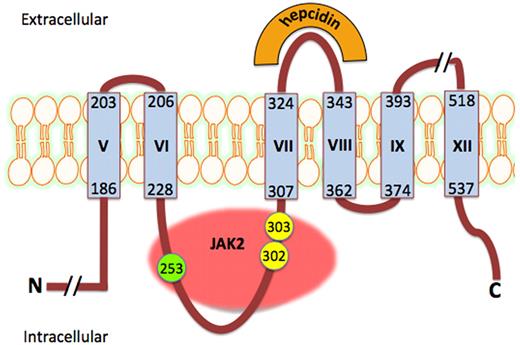In this issue of Blood, Sasu and colleagues demonstrate that a high-affinity antihepcidin antibody corrects iron-limited erythropoiesis in mice with the anemia of inflammation and restores responsiveness to erythropoietin.1 This represents the first whole animal model in which 2 easily administered agents (a monoclonal antibody and erythropoietin) successfully treated one of the most common forms of anemia affecting humans.
There are 3 findings that characterize the anemia of inflammation (AI, also called the anemia of chronic disease): hypoferremia with iron-limited erythropoiesis, a blunted response to erythropoietin, and a modest reduction in red cell survival.2,3 Hypoferremia is caused by inflammation-induced up-regulation of the iron-regulated hormone hepcidin.1 Hepcidin is synthesized in hepatocytes, macrophages, and other cells and binds to the cellular iron exporter ferroportin.4,5 Binding of hepcidin to ferroportin results in recruitment of Janus kinase 2 (JAK2) to a cytoplasmic domain of ferroportin (see figure), phosphorylation of ferroportin, and internalization and degradation of the hepcidin-ferroportin complex.6 Loss of cell-surface ferroportin prevents macrophages, absorptive enterocytes, and other cells from exporting iron, leading to cellular iron retention and hypoferremia.1 Transgenic mice overexpressing hepcidin recapitulate the iron abnormalities of AI and also demonstrate an impaired response to erythropoietin.7 Red cell survival, however, was not affected.
Hepcidin binds to a highly conserved domain on an extracellular loop of ferroportin.8 Binding of hepcidin results in recruitment of JAK2 to a not-yet-characterized intracellular domain. JAK2 phosphorylates tyrosines at positions 302 and 303. This phosphorylation event is required for internalization of ferroportin. Once internalized, lysine at position 253 is ubiquitinated, targeting the protein for lysosomal degradation. Ferroportin functions as a homodimer and binding of hepcidin to both monomers is required to initiate internalization.
Hepcidin binds to a highly conserved domain on an extracellular loop of ferroportin.8 Binding of hepcidin results in recruitment of JAK2 to a not-yet-characterized intracellular domain. JAK2 phosphorylates tyrosines at positions 302 and 303. This phosphorylation event is required for internalization of ferroportin. Once internalized, lysine at position 253 is ubiquitinated, targeting the protein for lysosomal degradation. Ferroportin functions as a homodimer and binding of hepcidin to both monomers is required to initiate internalization.
In this issue, Sasu at al have created a mouse model of AI using treatment with heat-killed Brucella abortus. Knock-in technology was used to generate mice expressing human rather than murine hepcidin and AI was then induced. Administration of a high-affinity monoclonal antihuman hepcidin antibody corrected the hypoferremia, but also restored responsiveness to erythropoietin. Red cell survival was not measured. In the absence of the antibody, intravenous iron therapy did not restore responsiveness to erythropoietin, indicating that the effects of the antihepcidin antibody are mediated by factors beyond iron.
The finding that binding of hepcidin to ferroportin results in recruitment of JAK2 suggests the presence of an intracellular signaling pathway mediated through JAK2. Attenuating this pathway by neutralizing hepcidin may explain the effect of the antihepcidin antibody on the erythropoietin response. Other effects of a hepcidin-ferroportin-JAK2 signaling pathway, some of which might be beneficial in face of inflammation, are also possible.
Conflict-of-interest disclosure: The author declares no competing financial interests. ■


This feature is available to Subscribers Only
Sign In or Create an Account Close Modal